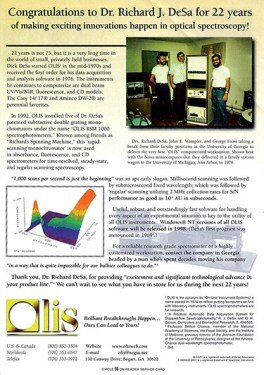An Unbiased View of Circular Dichroism
An Unbiased View of Circular Dichroism
Blog Article
Facts About Spectrophotometers Revealed
Table of ContentsLittle Known Facts About Spectrophotometers.The 9-Minute Rule for Uv/vis/nirIndicators on Uv/vis You Should KnowThe Ultimate Guide To Uv/visHow Uv/vis can Save You Time, Stress, and Money.

Spectrophotometry is most commonly used to ultraviolet, visible, and infrared radiation, modern spectrophotometers can question broad swaths of the electro-magnetic spectrum, consisting of x-ray, ultraviolet, visible, infrared, and/or microwave wavelengths. Spectrophotometry is a tool that hinges on the quantitative analysis of particles depending upon how much light is absorbed by colored compounds.
Little Known Questions About Uv/vis/nir.
A spectrophotometer is typically used for the measurement of transmittance or reflectance of services, transparent or nontransparent solids, such as polished glass, or gases. Numerous biochemicals are colored, as in, they take in visible light and therefore can be measured by colorimetric procedures, even colorless biochemicals can typically be converted to colored compounds appropriate for chromogenic color-forming reactions to yield substances ideal for colorimetric analysis.: 65 However, they can also be designed to measure the diffusivity on any of the listed light varieties that normally cover around 2002500 nm utilizing different controls and calibrations.
An example of an experiment in which spectrophotometry is used is the determination of the stability constant of an option. A specific chain reaction within a service might take place in a forward and reverse instructions, where reactants form products and items break down into reactants. At some point, this chain reaction will reach a point of balance called a balance point.
The 6-Minute Rule for Circularly Polarized Luminescence
The quantity of light that travels through the service is indicative of the concentration of certain chemicals that do not permit light to go through. The absorption of light is due to the interaction of light with the electronic and vibrational modes of molecules. Each kind of particle has an individual set of energy levels related to the makeup of its chemical bonds and nuclei and therefore will absorb light of particular wavelengths, or energies, resulting in distinct spectral residential or commercial properties.
They are commonly utilized in numerous markets consisting of semiconductors, laser and optical manufacturing, printing and forensic assessment, as well as in laboratories for the research study of chemical substances. Spectrophotometry is frequently utilized in measurements of enzyme activities, determinations of protein concentrations, determinations of enzymatic kinetic constants, and measurements of ligand binding reactions.: 65 Eventually, a spectrophotometer is able to determine, depending on the control or calibration, what compounds are present in a target and precisely how much through calculations of observed wavelengths.
Created by Arnold O. Beckman in 1940 [], the spectrophotometer was developed with the aid of his associates at his business National Technical Laboratories founded in 1935 which would end up being Beckman Instrument Business and ultimately Beckman Coulter. This would come as a service to the formerly produced spectrophotometers which were not able to absorb the ultraviolet correctly.
The 8-Second Trick For Uv/vis
It would be found that this did not offer acceptable outcomes, for that reason in Design B, there was a shift from a glass to a quartz prism which enabled better absorbance outcomes - UV/Vis/NIR (https://www.blogtalkradio.com/olisclarity1). From there, Model C was born with a modification to the wavelength resolution which ended up having 3 systems of it produced
It was produced from 1941 to 1976 where the price for it in 1941 was US$723 (far-UV accessories were an option at extra expense). In the words of Nobel chemistry laureate Bruce Merrifield, it was "probably the most crucial instrument ever established towards the development of bioscience." Once it became ceased in 1976, Hewlett-Packard developed the first commercially readily available diode-array spectrophotometer in 1979 referred to as the HP 8450A. It irradiates the sample with polychromatic light which the sample absorbs depending upon its residential or commercial properties. It is sent back by grating the photodiode array which detects the wavelength area of the spectrum. Ever since, the production and implementation of spectrophotometry devices has increased profoundly and has actually become one of the most ingenious instruments of our time.

Get This Report on Circularly Polarized Luminescence
Historically, spectrophotometers use a monochromator containing a diffraction grating to produce the analytical spectrum. The grating can either be movable or fixed. If a single detector, go such as a photomultiplier tube or photodiode is utilized, the grating can be scanned stepwise (scanning spectrophotometer) so that the detector can determine the light strength at each wavelength (which will represent each "action").
In such systems, the grating is repaired and the intensity of each wavelength of light is measured by a different detector in the selection. Furthermore, most modern-day mid-infrared spectrophotometers use a Fourier transform technique to obtain the spectral details - https://www.indiegogo.com/individuals/36812837. This technique is called Fourier change infrared spectroscopy. When making transmission measurements, the spectrophotometer quantitatively compares the portion of light that travels through a reference solution and a test service, then electronically compares the intensities of the 2 signals and computes the percentage of transmission of the sample compared to the recommendation standard.

Report this page